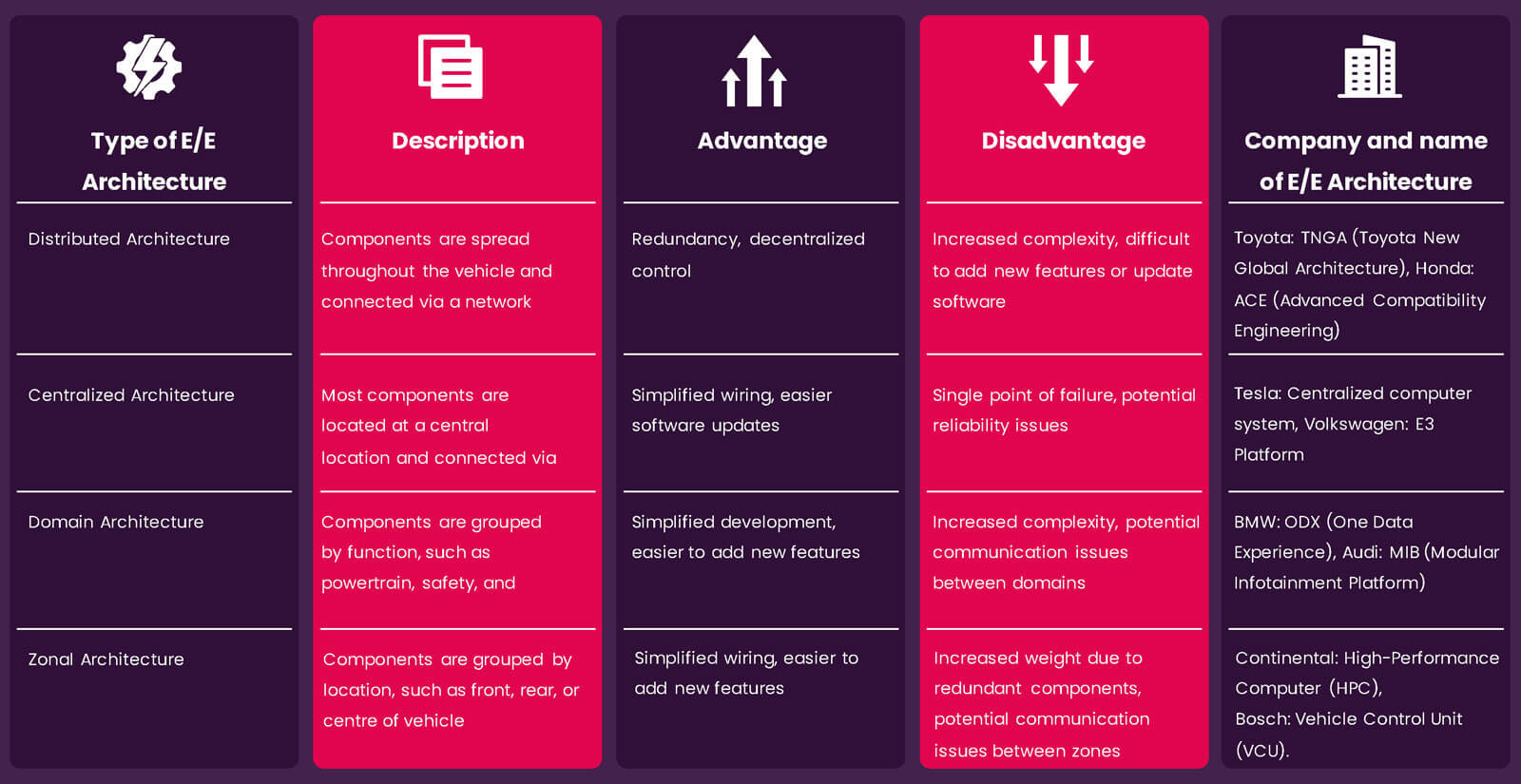Shift to advanced E/E architecture
The automotive industry has been witnessing a massive transformation in vehicle architecture in recent years. The traditional approach to designing and manufacturing vehicles is gradually giving way to electric/electronic (E/E) architecture. The new approach is driven by the increasing popularity of connected, autonomous, shared, and electric mobility and the need to build intelligent, connected, and sustainable vehicles.
Role of E/E architecture
E/E architecture is a complex system that integrates several components and technologies to deliver an enhanced driving experience. These components cover powertrain, advanced driver assistance systems (ADAS), infotainment, telematics, and cybersecurity.
Types of E/E architecture and companies adopting them

Challenges to advanced E/E architecture implementation
- Cost: The development and implementation of advanced E/E architecture can be costly, as it requires the use of expensive components and specialized software, as well as extensive testing.
- Complexity: Advanced E/E architecture can be complex, as multiple systems and components are integrated into a single network. Managing such complexity and ensuring the interoperability of various components can be challenging.
- Safety: Advanced E/E architecture, especially in autonomous vehicles, must be designed with safety in mind. The proper functioning of sensors, processors, and other components is critical to avoiding accidents and ensuring passenger safety.
- Standardization: In view of the wide range of components and systems involved in advanced E/E architecture, standardization is essential. However, achieving standardized interfaces and protocols can be challenging due to the diverse range of manufacturers and suppliers involved.
- Cybersecurity: As advanced E/E architectures relies heavily on software and communications systems, it is vulnerable to cyber attacks. Ensuring cybersecurity in vehicles is crucial to prevent unauthorized access and control of critical systems.
- Regulatory compliance: Advanced E/E architecture in vehicles must comply with various regulatory requirements, such as those related to emissions, safety, and cybersecurity.
Future of E/E architecture
Future of E/E (Electrical/Electronic) architecture in vehicles is expected to be heavily influenced by rapid technological advancements and changing consumer demands. Some of the key trends that are likely to shape E/E architecture are:
- Electrification: With increasing focus on reducing emissions and shift towards electric vehicles, E/E architecture will need to be designed to support high-voltage electrical systems, battery management systems, and electric powertrain components.
- Connectivity: Consumers are increasingly demanding more connectivity features, such as advanced infotainment systems, internet connectivity, and ADAS. As a result, E/E architecture will need support these features and enable seamless integration with external networks.
- Autonomous driving: As the development of autonomous vehicles continues, E/E architecture will need to support a complex array of sensors, processors, and communications systems required for self-driving capabilities.
- Modular design: To enable greater flexibility and scalability, future E/E architecture is likely to be based on modular designs, allowing easier integration of new technologies and components.
- Cybersecurity: As vehicles become more connected and rely on increasingly sophisticated E/E systems, cybersecurity will become a crucial aspect of vehicle design. E/E architecture will need to incorporate robust security measures to protect against cyber threats.
Overall, the future of E/E architecture is expected to be characterized by greater electrification, connectivity, and autonomy, with a focus on modularity and cybersecurity.
Download and read the full industry insight HERE
Learn more about the future, implications, and benefits of E/E architecture through Evaluserve’s Future Mobility Radar. If you have any questions, feel free to contact us at futuremobility@evalueserve.com


